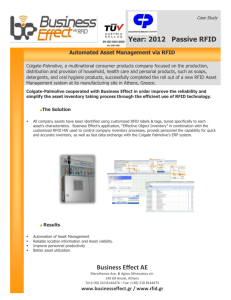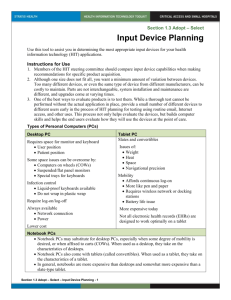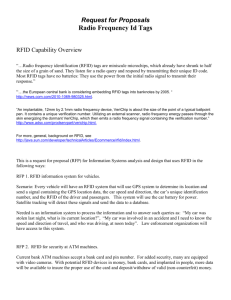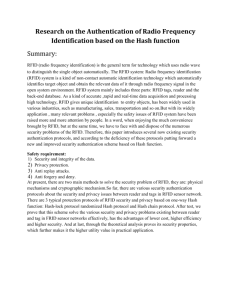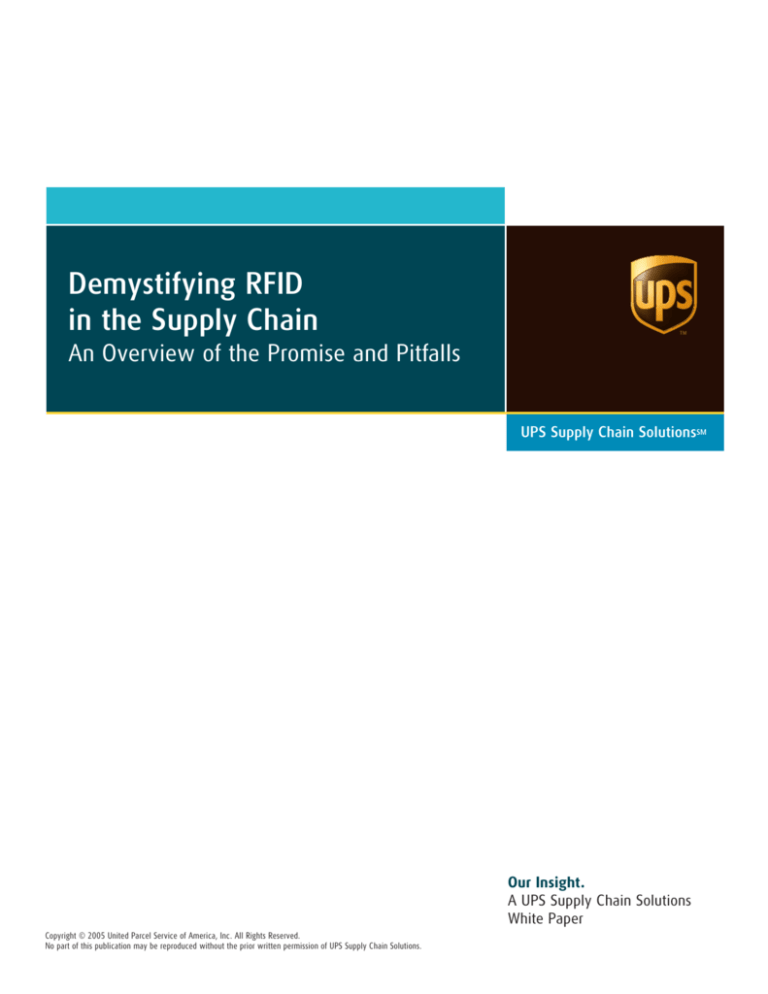
Demystifying RFID
in the Supply Chain
An Overview of the Promise and Pitfalls
UPS Supply Chain SolutionsSM
Our Insight.
A UPS Supply Chain Solutions
White Paper
Copyright © 2005 United Parcel Service of America, Inc. All Rights Reserved.
No part of this publication may be reproduced without the prior written permission of UPS Supply Chain Solutions.
Introduction
Imagine that on your way to work, a traffic light at a major intersection flashed
red, yellow and green, all at the same time. Should you stop, proceed slowly or
accelerate? Many companies are facing a similar predicament when considering
Radio Frequency Identification (RFID) technology as a new tool for supply chain
efficiency. Should they embrace it, if so when, what are the potential benefits, and
what are the potential pitfalls?
RFID is essentially a carrier
technology that best fits under
the umbrella of automatic
identification.
Recently, Wal-Mart and the Department of Defense (DOD) told their top suppliers
to begin tagging cases and pallets with RFID tags by January of 2005. The balance
of Wal-Mart suppliers are expected to comply with RFID tagging by 2006. Tesco
and Target Stores have recently told their suppliers to prepare shipments with RFID
tags. The impact of this goes far beyond those under compliance pressures today.
Indeed, Gartner anticipates that by 2012 most “enterprises will be forced to
redesign their value chain processes as a result of RFID changing the storage,
collection, and use of data concerning goods in the supply chain.”1
Not surprisingly solution providers are lining up to help these firms become
compliant and RFID ready. To equipment providers, software companies, and
systems integrators, there is a virtual gold rush to capture the new market. Add this
to the processes and products, once considered off limits for RFID applications are
now on the radar screen for improvement. If predictions are true, then the RFID
market will approach $3 billion by 2009.2 The stakes are high for competitive
positioning and the time is right to develop an RFID strategy.
Simplifying the Technology – An Overview of RFID
RFID is essentially a carrier technology that best fits under the umbrella of
automatic identification. The Electronic Product Code (EPC) is the more specific
term for an entire system that is planned for companies to more effectively track
and manage assets. This new identification system has the characteristics of
interoperability and open standards backed by EPC Global, a partnership of the
Uniform Code Council and European Article Numbering International (EAN).
The components of an EPC system enabled by RFID are:
Electronic Product Code – a metacode data structure developed by the Auto-ID
Center to uniquely identify virtually any kind of physical asset, such as a pallet or
a consumer product. The EPC structure can adopt other industry standard coding
schemes into its structure. The number is contained in a radio frequency tag as a
license plate, indexed to a store of related information. The EPC is expected to
replace the 12 character Universal Product Code (UPC) over time.
RF Tags – hardware components that carry the data about the item, including the
EPC. There are many classes of tags that scale in functionality and cost. Passive tags
are less costly, derive their power from the reader’s magnetic field and generally
have short read ranges. Active tags have their own power source, longer read
ranges and are generally much more expensive than passive tags.
Prediction – By 2008, RFID and e-tagging technologies will drive broad application innovation, Gartner, Inc., SPA-21-6374,
December 03, 2003.
2
“RFID: Smart Tags, High Costs,” ComputerWorld, December 15th, 2003
1
UPS Supply Chain Solutions
1
Tag Classifications
CLASS
COMMENTS
Class 0
Read-only: passive identity tags
Class I
Write-once passive identity tags. It is possible to unlock a Class I tag for rewrite.
Class II
Read-write passive tags with added functionality, e.g., memory or encryption
Class III
Semi-passive RFID tags
Class IV
Active tags- communicate with readers and other tags on the same frequency band
Class V
Essentially readers – can power Class I, II and III tags as well as communicate with
Class IV and with each other
Radio Frequency Bands
FREQUENCY
BENEFITS
DRAWBACKS
COMMON APPLICATIONS
LOW
9-135 KHz
• Accepted worldwide
• Works near metal
• Inside use today
• <1.5m Read Range
• Impractical for
warehouse operations
• Not in EPC Standards
• Animal ID
• Beer Kegs
• Auto Key & Lock
• Library Books
HIGH
13.56 MHz
• Accepted worldwide
• Works near metal
• Inside use today
• <1.5m Read Range
• Does not work near metal
• Item level tracking
• Airline baggage
• Building access
• Longer read range
potential, > 1.5m
• Not readily useable in Japan • Case, pallet and container tracking
• Does not work in moist
• Truck and trailer tracking
environments
• Detuning when tags in
close proximity
ULTRA HIGH
300-1200
MICROWAVE
2.45 OR 5.8 GHz
• Longer read range
• No commercial use license
potential, > 1.5m
in parts of EU
• Growing commercial use • Complex systems
development
• Access control (vehicles)
Antenna – wire, coil or printed conductive inks that transmit or reflect radio
waves. Antennas are always part of a reader system - some readers have
separately attached antennas, while other readers have integrated antennas.
Reader – also know as an “interrogator,” this is a data capture device that
communicates with tags, savants and computer networks.
Savants – local data repositories for EPCs and linked information; also support
middleware that brokers information through PML (Physical Markup Language).
Object Name Service (ONS) – the resource that points electronic inquiries to the
location of EPC data. It is very similar to the common Domain Name Service
(DNS) used to access internet addresses.
UPS Supply Chain Solutions
2
EPC Information Services – a suite of services, data structure and query language
for data collection and sharing among trading partners.
Throughout the distribution
lifecycle, RFID readers capture
and publish time and locations
data to provide visibility to
supply chain trading partners.
A Simplified RFID Example: Manufacturer-To-Retailer Supply Chain
While there are many possible variations, a basic vision proposed for the RFID
in a manufacturer-to-retailer supply chain is depicted as follows:
1. The manufacturer places RFID tags with EPCs on products or in packaging to
enable item tracking, history file creation, and future trading partner use (e.g.,
retail point-of-sale).
2. The manufacturer references the EPCs for linking cartons or pallets for
shipment building, package sortation, and Advanced Shipment Notification.
3. Throughout the distribution lifecycle, RFID readers capture and publish time
and location data (at a minimum) to provide visibility to supply chain trading
partners. Subject to implementation guidelines, the information would reside
on servers accessed via PML queries using the Object Name Service described
above.
4. The retailer or wholesaler receives the advance shipment notification
containing the EPC information, and automatically posts the receipt upon
goods arrival without human intervention.
5. At the retail store, checkout, inventory management and replenishment are
automated because of RFID enabled capabilities.
It is important to note that these types of automated processes are possible only if
the trading partners involved have collaborated and designed their business
processes accordingly. Further, near-term efforts with RFID will focus upon pallet
and carton level tagging, not item level tagging.
Inventory obsolescence,
pilferage, and stock-out are
promising areas for RFID.
The Promise and the Pitfalls of RFID
Within the realm of supply chain management there have been significant
market inefficiencies that traditionally were considered out of reach because
of the high costs required to address them or the lack of effective solutions.
Some examples of these inefficiencies include “just-in-case” inventory costs,
inventory obsolescence, pilferage and stock-outs. These are the areas where
RFID is generating interest and the most promise – achieving greater supply
chain efficiency.
The Promise of RFID
Recent advancements in RFID technology coupled with decreasing costs have
allowed RFID to gain greater prominence and therefore a higher level of
adoption. The following are examples of the unique capabilities offered by RFID:
Orientation independence – RF tags do not require line of sight as in the case
of barcodes. This eliminates some of the additional steps required to orient the
object toward the scanner
UPS Supply Chain Solutions
3
Information capabilities – Different tag types have a broad range of options for
data content and read-write capabilities. The communication of this data could
be harnessed for near real-time event management and decision making.
Asset security and monitoring – RFID can be coupled with sensors to record
and store changes in temperature, movement or other environmental conditions.
Tag Durability – Barcodes can be easily marred or otherwise damaged in diverse
operating environments and RF tags are typically much more durable.
Real-time data capture – For many companies, the “killer app” of this
solution will be harnessing real-time data to drive business value. Being
able to answer questions such as “where are the assets right now?” or
“how many assets are there right now?” will allow firms to automate
business processes and decision making.
Because of the perceived benefits of these features, more companies are
implementing RFID and experiencing tangible results. The most prominent
applications are:
APPLICATIONS
EXAMPLES
Process Automation
RFID events can trigger parallel
and downstream processes
Asset Security
Anti-counterfeit, anti-theft, intrusion detection
and environmental monitoring
Labor Reduction
Passive readers reduce scanning
and handling labor
Compliance
Documents, product expiration, etc. can be indexed
or stored on the chip
Inventory Management
“Smart” tags report physical inventory
counts or movement
Asset Tracking
Accounting for unit load devices, vehicles,
or other assets can be automated
Automated sortation
Packages, etc. sorted to correct dock door
via tag information
Auto-replenishment
“Smart shelves” generate orders based on tag
and inventory data
Payment processing
Automated authorization (e.g. pre-payment
for gasoline purchase)
Returns processing
Verification of returnable status and product identity
are on the tag or can be referenced through databases.
UPS Supply Chain Solutions
4
With RFID, Wal-Mart hopes to decrease stock-outs, which may cost as much
as four percent of revenue, through better visibility.3 Marks and Spencer, an
English retailer, has already seen improvements in tracking high-ticket
merchandise and lowering the volume of theft. The Department of Defense
intends to realize real-time tracking of assets such as tanks, jeeps, and supply
vehicles. Additional examples of companies implementing RFID include:
TAG
CHIP TYPE
PASSIVE/ACTIVE (MHZ)
READ/WRITE YEAR
COMPANY
ITEM TAGGED
Harley
Davidson
Bins carrying parts
of custom
motorcycles
during assembly
•
13.56
•
•
Toyota:
Phase1
Carriers containing
car frames as they
move through
paint stations
during production
•
13.56
•
TrenStar
Beer kegs as they
move through the
supply chain
•
125-128
•
International
Paper
Cores of large paper
rolls moving
through the
warehouse
•
915
•
Gap
Denim apparel
through the supply
chain and onto
store shelves
•
13.56
•
Raxel
Reusable plastic
containers for
carrying
biohazardous waste
•
125-128
•
•
Michelin
Tires
Las Vegas
Airport
Airline baggage tags
Department
of Defense
Shipping containers
•
STAGE
OUTCOME
1998
Rollout
Automatically displayed
manufacturing instructions
for employees at each stage
of the assembly process
•
2001
Rollout
Streamlined manufacturing
and vehicle tracking; saves
on interest charges
•
2001
Rollout
Improved demand forecasts
and increased efficiency;
identification of blackmarket sales and elimination
of misdirected shipments
2003
Running
Reduction of lost and
misdirected paper rolls
•
2001
Pilot
Improved customer service
through better inventory
management on shop floor;
increased supply chain
efficiency and data accuracy
•
•
2002
Implemented
Avoid contamination by
ensuring proper cleaning,
asset visibility
905-928
•
•
2003
Running
Compliance with the
TREAD Act and recall
905-928
•
•
2003
Deployment
Automated rerouting of
baggage and increased
accuracy 99.5% up from
70%-85% accuracy with
barcodes to ensure that
they send each bag back
to the right airline
433
•
•
1994
Rollout
90% reduction in the
number of containers
required
“The RFID Imperative,” CIO Magazine, December 1, 2003.
3
UPS Supply Chain Solutions
5
Who Benefits from RFID and How
Who benefits from RFID enablement will depend upon the applications and the
trading partner relationships. As an example, the outlook for manufacturers is
quite different from that of retailers. Proponents of RFID state that manufacturers
can benefit primarily from:
• Reduced retail stock-outs, providing more volume and revenue
to manufacturers
• Improved asset visibility, leading to improved asset utilization and working
capital efficiency
• Real-time decision making capabilities – routing, sorting, recalls, etc.
• Improved product returns management
• Counterfeit prevention
• Obsolescence prevention
Manufacturers under a compliance mandate will experience little benefit from
the effort unless they can effectively redesign business processes to internally
take advantage of the event-based data. Time is of the essence for many of these
firms to both meet compliance objectives and change internal processes for
mutual benefit.
Retailers can see more immediate benefits when a critical mass of RFID tags
are in place. Such benefits include:4
BENEFITS OF RFID
Consumers can also benefit
from RFID with improved
service, availability of items,
product and service quality,
and more.
• Decreased inventory of as much as 5% of total inventory
• Reduced labor costs in stores and warehouses, as much as 7.5% has
been estimated
• Reduced stock-outs, as high as 7% of revenues
• Reduced shrinkage by theft -- this is a multi-billion dollar issue
• Increased inventory accuracy
• Automated replenishment
• Counterfeit prevention
• Obsolescence prevention
Consumers can also benefit from RFID, but it depends upon how retail unit
tagging is carried out. The most common benefits possible are:
Improved service – potentially faster checkout avoiding traditional lines. Users
would wave an RFID enabled card near a reader, instantly completing the
purchasing transaction.
Improved availability of items – better visibility of products, allows for timely
ordering, manufacturing, distribution, and restocking of goods.
Improved product and service quality – manufacturers could quickly locate and
recall faulty products, even before they reach consumers.
The Pitfalls of RFID
Despite these enticing benefits, there are some issues with implementing RFID
applications in the global supply chain. These issues are well known to the
4
“AT Kearney Study Shows RFID Benefits For Retailers,“ www.itwebco.za, November 12, 2003.
UPS Supply Chain Solutions
6
More importantly, firms must
determine how they will use
the new data to change
business processes.
industry and solutions are in development. We will examine some of the more
prominent issues facing RFID implementation today that are important
strategy considerations.
Cost
One of the major inhibitors of RFID growth has been the cost of tags. When
firms multiplied tag costs by their annual volume, the extended costs did not
make sense due to significant profit margin impacts. Now that tag prices have
dropped and are projected to drop much further, the economics are more
compelling. Order volumes for tags are beginning to portend future scale – a
recent ten million unit tag order by International Paper is a prominent example.5
Obviously, whether tags will be reused or disposed of will be a cost driver that
should be considered. This will often be impacted by the level of partnering that
can be achieved by downstream trading partners who would actually carry out
any plans to return, reuse or discard the tags.
Tag costs are obviously the major variable cost component for RFID, but what
about other related cost components? Software, systems integration, process
redesign and organizational impacts will be significant and must be part of the
business case as well. With the anticipated scale and scope of RFID deployment,
tag costs are expected to continue their decline.
Early adopters of RFID are
developing processes to
improve read rates and solution
providers are fine tuning … to
improve readability.
Tag Readability
This issue has been mentioned in the business press as a significant stumbling
block, citing read rates in the 80%-90% range.6 However, recent conversations
with major companies in the testing phase cite read rates of nearly 100%.
Whether readability is an issue may well depend on:
• tag frequencies and ranges
• reader capabilities and locations
• operating environment (interference from other devices, temperature, humidity,
static, vibration, and shock)
• the type of assets being tagged (metal objects and liquid containing items tend
to create problems for read integrity of passive tags)
RFID are developing processes to improve read rates and solution providers are
fine tuning their products to further improve readability Real questions exist for
just how to accurately read some items, especially if they are nested within a
pallet. The scenario of using RFID for inventory certification and automated
replenishment is obviously not achievable unless read percentages are high.
The good news is that early adopters of RFID are developing processes to
improve read rates and solution providers are fine tuning their products to
further improve readability. Given the increasing demand for RFID and its
history of incremental improvement, readability issues will become manageable
for most applications.
Data Management
What will be done with the new influx of RFID data? This question is a timely
one, since most ERP systems and WMS systems are not designed for RFID data
5
6
Matrics -IP Press Release- “10 Million Tag Order”, December 16, 2003.
“Zebra Technologies Makes RFID Tags Beep,” AMR Research, December 3, 2003.
UPS Supply Chain Solutions
7
capture – both the data volume and its unique characteristics, such as the
Electronic Product Code. The Electronic Product Code will occupy a larger data
field than the Universal Product Code now in place. Software vendors have taken
notice of these issues and are beginning to offer solutions. New structures for
data management should be considered prior to any RFID investment. More
importantly, firms must determine how they will use the new data to change
business processes.
More importantly, firms must
determine how they will use
the new data to change
business processes.
Data Ownership and Sharing
A self-contained RFID implementation for tracking high value assets would not
be subject to the same issues as other implementations. The EPC vision where
multiple trading partners post and retrieve item specific data as it progresses
throughout the supply chain will be much more difficult to accomplish, due to
the issue of data ownership. The benefits of sharing data among multiple
parties can be significant – the willingness of the participants to do so has
historically been a challenge.
Standards
Someone once said that the nice thing about standards is that there are so many
to choose from, and RFID is no exception. As with other technologies, there are
both proprietary and open standards for how data is structured, communicated
and managed among trading partners and within applications. There are
significant efforts underway by standards bodies to converge on common
requirements, but there will be differences based upon applications and other
factors. Tag operating frequencies will differ between the United States and other
regions for quite some time. Support for open standards and multiple frequency
readers make sense for global supply chains. These considerations should not be
major stumbling blocks to determine the business value of RFID.
Business Process Changes
Process automation through RFID will require new work methods and
performance measurements for the supply chain. The degree of difficulty will be
comparable to that of other systems implementations, where significant impacts
to process, organization and technology are commonplace. The design of any
RFID strategy must consider new processes and procedures to automate tasks and
decision making where possible, as well as consider organizational changes.
There are significant efforts
underway by standards bodies
to converge on common
requirements.
Privacy Concerns
While we may be several years away from individual retail item being tagged with
electronic product codes, the media has focused on the concerns of individual
privacy. The main concern is that consumers do not want themselves or the items
they purchase to be tracked once they own the item. The industry has developed a
“kill tag” feature that would disable the RFID functions once ownership is
transferred at retail. Additionally, the inability to read tags from long distances
should alleviate some fears of compromised privacy. Because privacy is so
important, firms can expect this to be an issue for some time, with ultimate
resolution through voluntary adherence to industry standards or through
involuntary government regulation.
UPS Supply Chain Solutions
8
Key Strategy Considerations
So what should firms be doing about RFID in light of the mixed messages?
To gain strategic perspective on RFID, we recommend the following:
Invest in pilot tests to
determine the capabilities and
limitations for the software and
hardware…true costs and
benefits….
Conduct Education and Research
• Begin an RFID education effort with a dedicated team that is chartered to
recommend and follow a course of action
• Research the standards development underway to ensure that the technologies
under consideration will meet both domestic and global standards.
Build a Robust Business Case
• Ensure that decisions are fact-based, beginning with the high-level business case.
A technology neutral partner who is experienced in RFID may be best able to
assist you.
• The business case should include a comparison of RFID capabilities with
traditional bar-code capabilities. There are unique differences between the
technologies which may spell out clear applications for RFID. There are also
some overlapping applications where optical barcodes will continue to be most
appropriate.
Establish Requirements
• Analyze databases and business processes for the impact of Electronic Product
Code requirements. Mandates are sure to come in this area.
• Determine the business needs for static data (beyond identification) to reside
on the asset. The ability to reference dynamic data is often preferable to static
data because of the need to change some characteristic or event linked to the
asset.
• Do not underestimate the need to change business processes to achieve the
automation and asset visibility that RFID can provide.
Pilot Before Implementing
• Invest in pilot tests to determine the capabilities and limitations of the software
and hardware, as well as the true costs and benefits of RFID. Update the
business case based upon the findings.
Plan
• For RFID mandates, determine how to balance compliance with the long-term
interests of the business. Ensure that short-term investments in compliance can
be scalable to address other customer and internal business needs.
• Plan for co-existence of barcodes and RFID for an extended period – to be
measured in years.
Our Point of View
Despite the hype, the promise of RFID technology is real, and can provide
increased asset visibility, enhanced information content and velocity. Equally
as real are the pitfalls of RFID including cost, competing standards, technology
limitations and privacy concerns.
UPS Supply Chain Solutions
9
Anticipate the ROI will be low,
but future gains are possible by
redesigning business processes.
Recent compliance requirements from Wal-Mart, Target, the Department of
Defense and others will have a ripple effect across industries, ultimately driving
significant adoption of RFID technology. The transition to RFID may not occur
overnight, but this technology has been given a jump start by these industry
leaders. Anticipate that return on investment for RFID will be low or non-existent
initially, but that future gains are possible by redesigning business processes.
Further, significant technical implementation and cost hurdles to RFID
implementation should continue to drop over the next several years.
There are costs to both taking action and not taking action – the greater risk may
be to ignore the opportunity. We recommend RFID education and development of
the business case and pilot to size the potential benefits and adoption efforts.
Finally, we recommend the design of an Auto-ID strategy with a focus upon how
business processes and the customer experience can be improved.
About the Authors
Michael Sullivan is a Principal Consultant at UPS Supply Chain Solutions.
Michael is based in Atlanta, GA and can be reached at msullivan@upsscs.com
Susan Happek is a Principal Consultant at UPS Supply Chain Solutions.
Susan is based in Atlanta, GA and can be reached at shappek@ups-scs.com.
To learn more about how our experience in supply chains and consulting can
benefit your business, please contact us:
1.800.742.5727 U.S.
678.746.4365 International
Visit us at ups-scs.com
About UPS Supply Chain Solutions
By aligning a client’s business strategies with its operating processes, UPS
Supply Chain Solutions can create high-performance supply chains that from
inception to implementation generate real, hard-number values and quick
benefit realization. This distinguishing capability, our experience in solving
real-world challenges, and the resources of UPS enable us to set strategies,
design and build solutions as well as implement, operate, manage and
synchronize your world of commerce.
Copyright © 2005 United Parcel Service of America, Inc. All Rights Reserved. WP.SCS.HT.629
No part of this publication may be reproduced without the prior written permission of UPS Supply Chain Solutions.
UPS Supply Chain Solutions
10




